ITM Tilburg IBA 2025
1/90
There's no tags or description
Looks like no tags are added yet.
Name | Mastery | Learn | Test | Matching | Spaced |
|---|
No study sessions yet.
91 Terms
Disadvantage of a large firm
Beyond a certain point, an increasing firm size can be disastrous due to inertia
Structural differences between small and large firms
Large firms are more hierarchial than small firms
Large firms are more vulnerable to stakeholder pressures
Large firms’ managers are more susceptible to cognitive inertia and agency concerns
Innovation
Transformation of an existing state of things to introduce something new
Process of innovation
Identify a need or a problem
Develop a feasible solution
Produce/Manufacture and market the solution
Achieve adoption/diffusion of the innovation
Innovation from an entrepreneur’s/innovator’s perspective
A problem-solving process that involves searching for new combinations of various information and knowledge
The use of new knowledge (technological or/and market-related) to offer a new product or service that customers want
Economic Value
The value that a person places on an economic good based on the benefit that they derive from the good
Technology-Push factors
Technology-Push factors are driven by invention and commercialization of science and R&D, as well as by competition. They create new knowledge and methods
Demand-Pull factors
Originate from new needs and demand of consumers, which depend on their nature, type, size, and distribution
Schumpeterian view of innovation
Creative Destruction: Both small and large firms can create innovations by creating new technological knowledge —> Technology-Push innovations
Kirznerian view of innovation
Assumes the availability of knowledge and emphasizes the role of entrepreneurship in staying alert to demand-side opportunities and applying knowledge to address the demands and needs of consumers
Key organizational variables of innovation
Firm size
Scale of operations: Asset base and customer base
Scope of operations: Vertical scope, horizontal scope, and geographic cope
Age and experience
Awareness, level of knowledge, path dependence, and inertia
Market power and competition
Monopoly and incumbency
These factors play a crucial role in shaping the nature and type of innovations firms can imagine, foster, and produce
Types of innovation
Competence-enhanding
Incremential innovation
Knowledge for a new product built on current knowledge
iPhone 15
Competence-destroying
Radical innovation
Knowledge for a new product different from current knowledge
ChatGPT
Abernathy-Clark Model
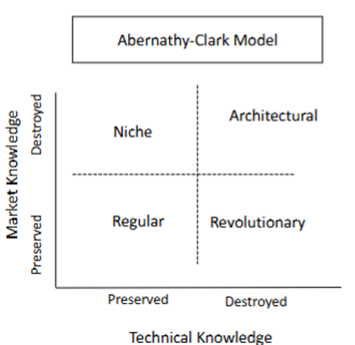
It takes a product market perspective and distinguishes between technical and market knowledge
Regular innovation
Niche innovation
Revolutionary innovation
Architectural innovation
Henderson-Clark Model
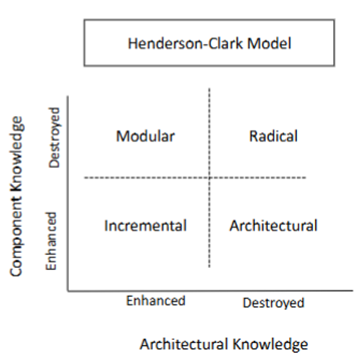
Emphasizes on the components of a product and the linkages between them. Distinguishes between component knowledge and architectural knowledge
Incremental Innovation
Modular Innovation
Architectural Innovation
Radical Innovation
Component Knowledge
The individual parts or technical tools that make up the product
Architectural Knowledge
The structural framework that defines how these components are integrated and interact
Organizational Economics
A branch of economics that focuses on the structure and behavior of organizations. It examines how firms and other institutions make decisions and how their structures affect their performance.
It includes the following three theories:
Information Economics
Transaction Cost Economics (TCE)
Resource-Based Theory
Information Economics
Both small and large firms face informational risks when dealing with their employees (internal) as well as when transacting with external parties
Hidden information risks
Adverse selection risks. Impedes the firm’s ability to secure resources and strike business partnerships
Hidden action problem
Moral hazard problem. A firm’s inability to verify and observe the actions and contributions of its employees, external contractors, etc.
Reduce hidden information risk for outsiders
Engage in costly signaling that helps them distinguish the underlying quality of their technology or activities (which are typically non-verifiable, non-measurable, and non-observable)
Mitigate hidden action problems
Through incentives and careful contract designs
Transaction Cost Economics (TCE)
Focuses on the challenges and costs associated with making business transactions
Transaction Costs
The extra costs incurred when making an economic exchange. These costs include the costs of gathering information, negotiating, making decisions, and enforcing contracts
Asset-Specificity
How specialized an asset is to a particular transaction or firm. Higher asset-specificity can lead to higher transaction costs because it limits the asset’s use in other transactions
Resource-Based Theory
Defines firms as a bundle of heterogeneous and complementary resources, which can be tangible and intangible
Key advantages of small firms
Knowledge Advantage
Small firms often have a head start due to their deep understanding or unique insight into specific technology or market needs
Key Individuals
Founders, investors, and intermediaries
Market Positioning Advantage
Their ability to identify and occupy niche markets or emerging opportunities before larger competitors can
Effectuation
Taking a set of means as given and focusing on possible outcomes that can be created with that set of means
Challenges of small firms
Lack of resources and networks
Lack of organizational history/experience, knowledge repositories, and stable organizational processes and routines
Lack of legitimacy and credibility: New market entrants often struggle to establish trust and authority in their domain
Sources of ideas, resources, knowledge, and opportunities in small firm innovation
Local technical, social, and user environment
Resource capital, assets, human capital
Prior work experience of employees; Prior failure experience
Social capital and embeddedness in local entrepreneurial and innovation context
Creativity and Personality traits
Analysis of the external environment and stakeholders include:
Paradigm analysis - Status-quo of a product or service
Market analysis
Competitor analysis
Community analysis
Interest group analysis
Government analysis
Interdependent components of start-up innovation strategy
IP strategy
Organizational strategy
Product market strategy
Digital and marketing strategy
Finance Strategy
IP Strategy
Patents, trademarks, copyrights, and secrecy
Organizational Strategy
Scale, scope, and vertical and horizontal boundaries
Product Market Strategy
A product’s price, quality, margin, target sales growth, and differentiation vs cost
Digital and Marketing Strategy
Digital and AI tools, and social media
Finance Strategy
Financial contracts: Loan convenants, options, and staging and milestone financing
Types of financing: Outside vs Self, debt vs equity, going public
Processes for feedback, information exchange, and coordination

Appropriability
The ability of an innovator to seize some of the social gains that result from an innovation
Appropriability Regime
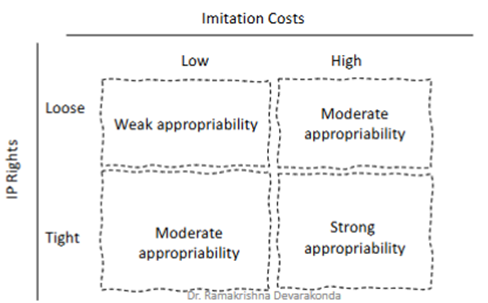
Determines the extent to which knowledge and innovations can be protected from imitation
Two critical drivers for small firm innovation
Access to complementary assets
Knowledge Capital
Financial Capital
Commercialization Capital
Safeguards against the risk of imitation and appropriation
Employee Mobility Risk
IP infringement and litigation
Core Assets and Competencies
Unique strengths deep inside a firm that differentiate them from other firms
Managerial Intentionality
Top-level managers seek to balance private and common interests
Innovative Performance
Super additive function of resources and managerial incentives
ITM = f(Resources) + g (Managerial Inducements) + h(Resources * Managerial Inducements)
Functional Capabilities
Capabilities from functional areas such as operations, purchasing, logistics, SCM, design, engineering, R&D, marketing, distribution, customer service, and financial management
Organizational Capabilities
Coordination and orchestration among functional areas
Corporate Renewal
A firm can modify its asset and capability base to gain and sustain a competitive advantage
Organizational Hierarchy
Board of Directors
Top level managers
Divisional managers
Other managers / Team leaders
Team members
Firms face the need for external sourcing of innovation, due to:
Pressures that firms face due to environmental changes and competition
Limited capabilities to adjust to changes; lack of relevant up-to-date complementary information and assets
Time-compressed diseconomies of scale and scope
Flexibility and Uncertainty
Pressure to act and respond fast
Main forces shaping innovation and technology on an industry level
Factor conditions
Demand conditions
Competitive rivalry and intensity
Related and supporting industry
Firms seeking international expansion strategies to commercialize their innovations or locate their value chain activities for innovation examine these conditions
Factor conditions
A nation’s endowments in terms of natural, human, and other resources
Universities, S&T centers of excellence
Demand conditions
Specific characteristics of demand in a firm’s domestic market
Market size, sophistication, specialized demand
Competitive rivalry and intensity
Firm networks and rivalry
Innovation intensity among firms
Highly competitive environments tend to stimulate firms to outperform others
Related and supporting industries
Supporting services, designs, distribution, and suppliers for other activities in the value chain
Complementarity
Leadership in related and supporting industries can also foster world-class competitors in the downstream industry
IP assets key characteristics
Publicness
Depreciation
Transfer costs
Property rights
Enforcement
Publicness IP
If IP assets are revealed, they become largely public, allowing others to access and use them if they are not properly protected
Depreciation IP
IP assets do not wear out physically, but they can lose value rapidly over time due to competition or loss of exclusivity
Transfer costs IP
The costs associated with transferring IP assets are hard to determine and increase when knowledge is more tacit (hard to codify and transfer)
Property rights IP
IP protection is limited to legal mechanisms such as patents, trade secrets, copyrights, and trademarks
Enforcement IP
Protecting IP assets is challenging
Legal forms of IP
Patents
Trade secrets
Trademarks
Copyrights
Patents
Legal rights to exclude others
Granted based on inventive step (non-obviousness), and industrial applicability (utility)
Protect an invention
But also, costly to obtain and protect from imitation
High enforcement costs
Trade secrets
Right to make, use and sell secret, as well as protect against misuse
Confidential, proprietary information - costly to maintain (protect)
High enforcement costs
Trademarks
Forbid against misuse of brand, misrepresent source
Protects goodwill - costly to maintain
Moderate enforcement costs
Copyrights
Right to produce, distribute, and use for further work
Protects ideas and artworks (e.g., software) - not costly to maintain (protect)
Costly to enforce
Strategy
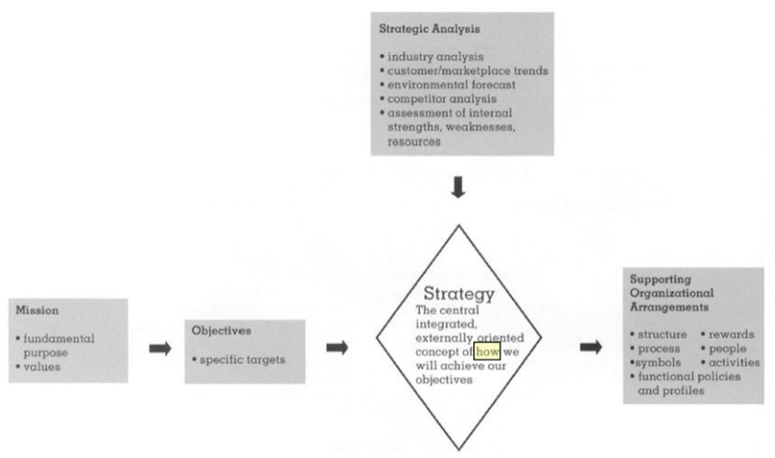
The central integrated, externally oriented concept of how we will achieve our objectives
Strategic Analysis
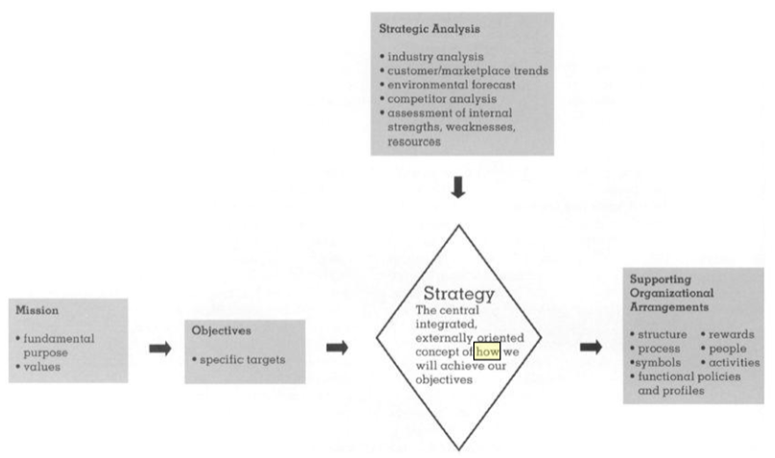
Industry analysis
Customer / Marketplace trends
Environmental forecast
Competitor analysis
Assessment of internal strengths, weaknesses, and resources
Supporting Organizational Arrangements
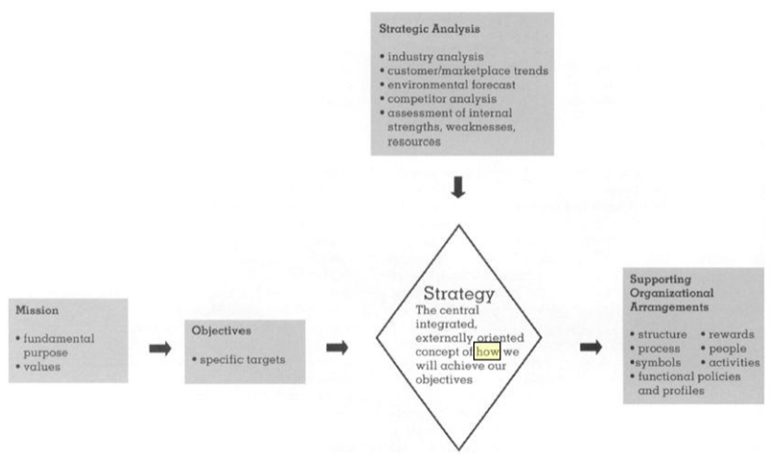
Structure
Process
Symbols
Rewards
People
Activities
Functional policies and profiles
These arrangements are made to access knowledge, resources, and capabilities. They cause a relational view of competitive advantage and allow the firms to obtain flexibility and reduced uncertainty
Ideas
Ideas are based on imagination, passion, and creativity, in combination with cross-disciplinary thinking
Creativity & Innovation
Creativity: The ability to produce work that is novel and useful
Innovation: The ability to turn creative ideas into viable solutions
Individual creativity is a function of:
Knowledge
Environment
Personality
Motivation
Intellectual abilities
Style of thinking
Enabling Technologies
Equipment and methodology that, alone or in combination with associated technologies, provides the means to generate giant leaps in performance and capabilities of the user
Preference effect
Researchers and firms engage in certain types of knowledge due to their intrinsic interests and incentives
Researchers might accept lower wages because they value working in science
Productivity effect
Efficiently generating valuable insights or innovations, and gaining spillover effects
If scientific work boosts a firm’s success, companies may share those gains with researchers through higher wages
Three key challenges in the management of human capital for innovation
Worker’s objectives do not perfectly align
Worker’s effort is hardly observed directly by managers - hidden action concern
Worker’s output is hardly unambiguously verified - hard to use as a contractual term
Autonomy
A worker’s freedom to make decisions within given organizational resource constraints for a specific task
Delegation
The act of transferring decision rights from the manager to the worker
Firm’s benefits (bF)
(𝜶 + 𝟏 − 𝝀) 𝒆𝒔𝑨
Worker’s benefits (bW)
𝝀𝒆𝒔𝑨
Disutility function of W
(1/2) * e2
Outside option of W
(1/2) (𝒔 2 + 𝜸)
Firm’s payoffs (𝝅)
(𝜶 + 𝟏 – 𝝀) 𝒆𝒔𝑨 – 𝒑
Where p = salary
Worker’s payoffs
𝒑 + 𝝀𝒆𝒔𝑨 – (1/𝟐)𝒆2
F solves the following problem
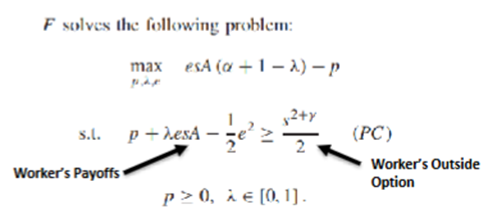
You want to set the ingredients 𝝀 and 𝒑 that will connect the decision rights (autonomy) and payment (and the unobserved effort e) with the project-specific skills s
Project Relevant Capital
Represents the resources and capabilities that contribute to both scientific and commercial value
Autonomy (𝝀)
The degree of independence in decision-making, which influences the trade-off between scientific and commercial value. A larger 𝝀 suggests greater freedom, which can enhance scientific outcomes but may reduce commercial viability (Change from p to p1). A smaller 𝝀 does the opposite
Positive association with Scientific Value
Local development unit (LDU)
Project size
Project budget
Positive association with Commercial Value
Project size
Project Relevant Capital (PRC)
Negative association with Commercial Value
Age of workers
Budget
Secondary Effect
Lower autonomy → Lower effort
Higher autonomy → Higher effort
Delegation with Low and High PRC
Low PRC pushes for more delegation due to motivational purposes
High PRC pushes for more delegation due to efficiency considerations (spillover effects)